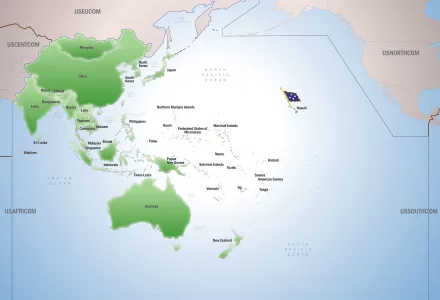
France and the United States are the two Western countries with the highest sovereign interests in the Indo-Pacific region. Ensuring sovereign integrity and the security of their citizens are the first strategic priority of both nations. Furthermore, as longtime allies, Washington and Paris share mutually supporting interests that align their geopolitical security within the diplomatic, economic, and military spheres. Traditionally thought of as national interests, many now transcend borders to reflect inclusive interests of both Washington and Paris versus the exclusivity of a single nation-state. There is an increasingly common strategic vision that can bolster regional security by developing physical and digital connectivity to ensure a free, safe, and open Indo-Pacific.
Shared strategic vision requires apt diagnosis of the state of play before consideration of potential policy prescriptions that might strengthen a unified approach to the Indo-Pacific. Foundational bedrock interests provide underlying structure and focus for both states. Strategists in Washington and Paris must continue to focus on first-level interests including maintaining productive relations with regional great powers to manage crisis and stave off any great power conflict, ensure the survival and active cooperation of key regional allies, and protect the viability and stability of major global systems including trade, financial markets, and energy. Second-level interests hold areas where there may be less consensus on the ways and means but implicit agreement on the nexus of interests and values: preventing, deterring, and reducing the use of nuclear, biological, or chemical weapons anywhere and preventing regional proliferation of weapons of mass destruction. Furthermore, safeguarding of democracy at home and around the world has increasingly become one of the highest second-level interests and might now be regarded as vital in what some have called a renewed competition between democracy and authoritarianism. Addressing human rights violations, preventing genocide, suppressing terrorism, constraining the emergence of regional hegemons, and promoting international policies to mitigate climate change further align priorities.
Washington and Paris can maximize positive outcomes and improve Indo-Pacific stability by reinforcing each other in the region. The United States remains highly focused on security with a large military component, strong historical alliances, and economic resources. France also has a sizeable military presence, maintains a geopolitical stature based on its vast territories, exclusive economic zone rights, and a unique position of influence within the European Union (EU) that can be leveraged to bring like-minded members to the table. With the diplomatic, economic, and military power of the United States and EU all focused on creating a free and open Indo-Pacific that complements the current international order, France and the United States can work more effectively together. Nonetheless, most Indo-Pacific nations face the terrible conundrum of having their security ensured by the greatest competitor of their economic guarantor and geographic neighbor. Favoring one alienates the other, breaching either the sense of safety or the prospect of livelihood. In this highly bipolar regional environment, France seeks to rally the EU to offer an alternative, convening model. Hence, the best yield for the United States might be achieved by leveraging an offset approach through France or the EU, thus offering a more “positive framing,” thereby mitigating the reactive devaluation effect and the associated pushback. Conversely, Paris and Brussels would feel better supported by the might of Washington’s diplomatic and military power when core interests or values are in peril.
The greatest challenge to shared prosperity remains an increasingly aggressive Chinese foreign policy. Beijing has assertively advanced their security interests in the region through the militarization of the South China Sea, border disputes, rebuffed on the “One China, Two Systems” with Hong Kong, and increased pressure on Taiwan through military exercises, crossing into Taiwan’s air defense identification zone numerous times. China is launching a third strategy of displacement, one that expands blunting and building efforts worldwide to displace the United States as the global leader. The Global China Initiative laid out by Beijing suggests China intends to become a global leader in terms of composite national strength and international influence, construct a ‘world-class army,’ be actively involved in ‘global governance,’ and foster ‘a new type of international relations and build a community with a shared future for mankind. China altered their foreign policy strategy to encompass “peripheral diplomacy,” recognizing the importance of the region in bolstering their economic development and regional influence.
In the heterotopian gray-zone struggle between authoritarianism and democracy, this stratagem of choice is reflected by Beijing in all their levers of statecraft. From diplomacy to trade and military incentivized cooperation, there are a wide array of tactics designed to exploit behavioral, cultural, and political biases and weaknesses. Naval coercion, information warfare, sovereign debt traps, currency manipulation, political meddling, lawfare, and other approaches shape outcomes favorable to China over time. Revisionist, yet incremental. Strategic in its ends, but peripheral in its means. Coercive, but not escalatory. Bluntly attributable, although officially deniable. Subversive, however conscious of adversarial interests. Manipulative, but empathetic and coordinated.
To reach their goal of national rejuvenation and the “Chinese Dream” by redefining the international order, China must first establish themselves as the regional hegemon and are thus focused on an expansionist agenda in East Asia. If China is moderately successful in this endeavor or pushes the United States and France further afield while breaking down other regional alliances, this would result in a dramatic shift in the balance of power and threaten the shared prosperity all the Indo-Pacific has enjoyed over the last decades.
To counter and balance these efforts, the United States, France, and the EU can better support Indo-Pacific allies in ways that underscore a shared strategic vision: collaboration, coordination, and consultation. The following recommendations reflect three distinct approaches, yet each build upon a framework in the pursuit of tangible interests driven by common values.
Mayo , Victoria , Eric Marguerite and Michael Miner . “Old Friends and New Horizons: Recalibrating American and French Indo-Pacific Strategy.” Edited by Angel, Natalia. Belfer Center for Science and International Affairs, Harvard Kennedy School, August 26, 2022






